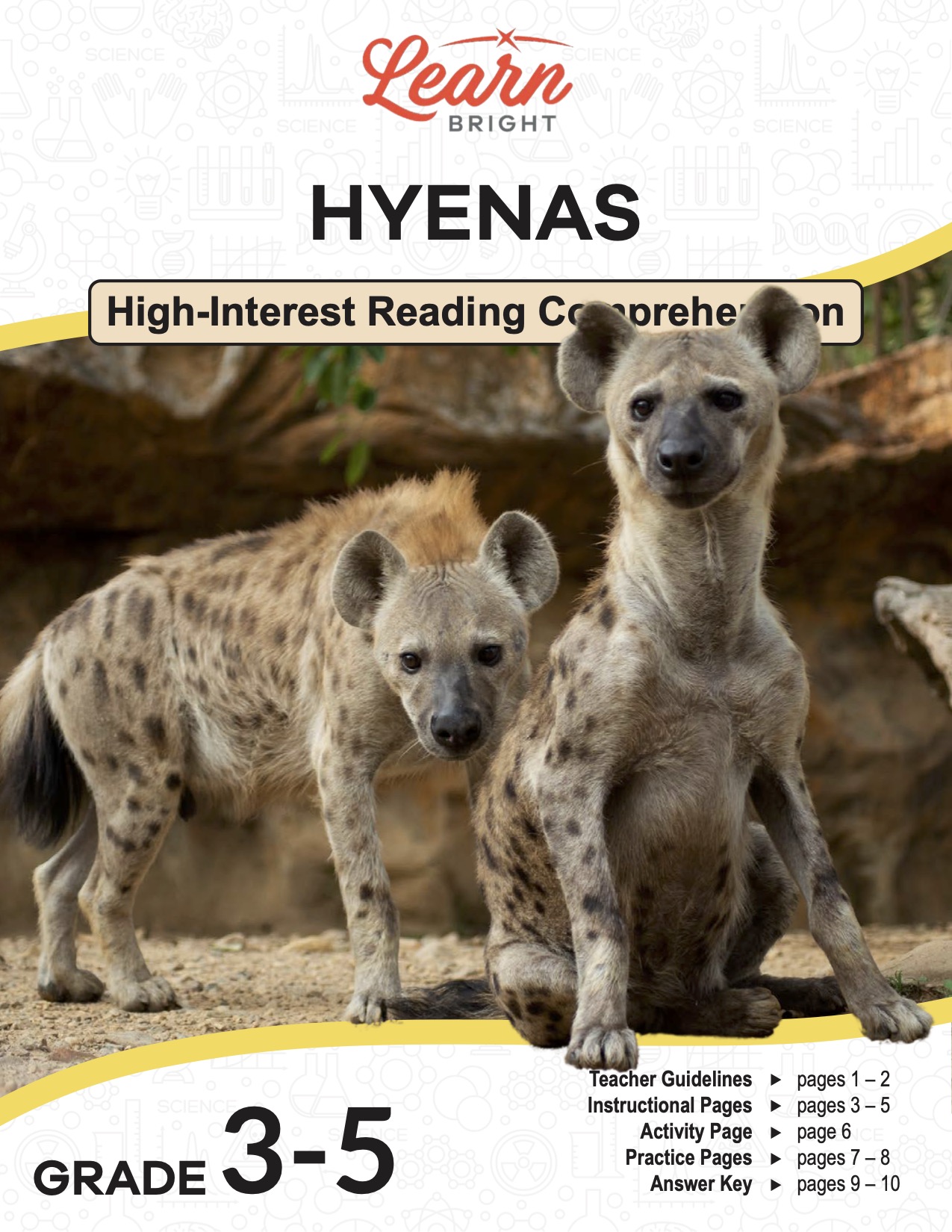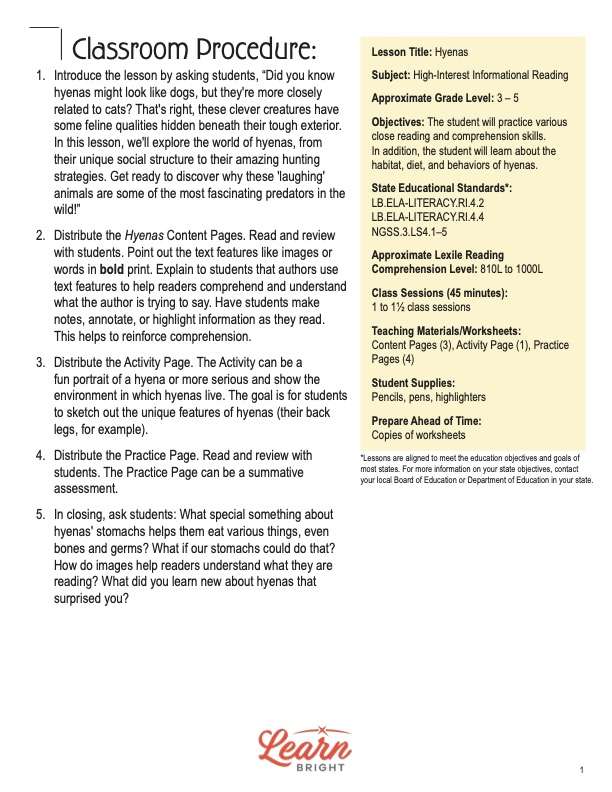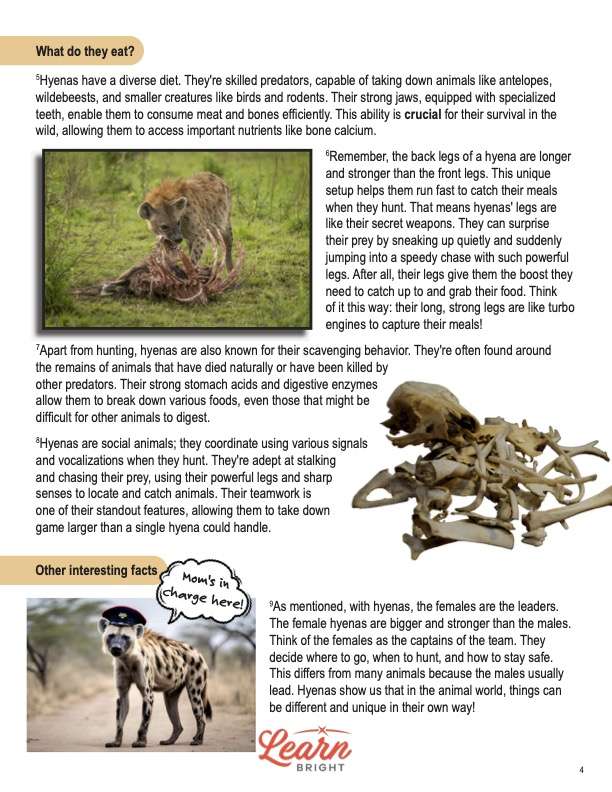Description
What our Hyenas lesson plan includes
Lesson Objectives and Overview: Hyenas is a high-interest reading comprehension lesson plan. As such, students will practice various close reading and comprehension skills. In addition, they will learn about the habitat, diet, and behaviors of hyenas. This lesson is for students in 3rd grade, 4th grade, and 5th grade.
Classroom Procedure
Every lesson plan provides you with a classroom procedure page that outlines a step-by-step guide to follow. You do not have to follow the guide exactly. The guide helps you organize the lesson and details when to hand out worksheets. It also lists information in the yellow box that you might find useful. You will find the lesson objectives, state standards, and number of class sessions the lesson should take to complete in this area. In addition, it describes the supplies you will need as well as what and how you need to prepare beforehand.
Teacher Notes
The teacher notes page provides an extra paragraph of information to help guide the lesson and remind you what to focus on. It explains that you can teach this lesson in a whole-class setting or as an independent, small-group activity. The blank lines on this page are available for you to write out thoughts and ideas you have as you prepare the lesson.
HYENAS LESSON PLAN CONTENT PAGES
What Are Hyenas?
The Hyenas lesson plan contains three content pages. To start off, it provides a small box with basic background information about hyenas. These mammals lives exclusively in the African savanna. They are carnivores that live for around 12 years.
Hyenas have unique physical features that help them thrive in their environment in Africa. Their bodies are covered in coarse fur in shades of brown, gray, or black. One distinct feature is their legs. The front legs are shorter than their hind legs, giving them a slightly sloping back. This unique body shape actually makes their back legs strong and powerful, which helps them run and chase prey.
Like cats, hyenas have strong jaws and impressive teeth adapted for their carnivorous diet. Their sharp teeth help them tear through meat and crush bones. They also have strong neck muscles that allow them to carry heavy prey and scavenge for leftovers. Their senses, like smelling and hearing, are highly developed, helping them find food and avoid danger.
These animals live in groups known as clans. The clans work together to hunt, protect their territory, and raise their young. Hyenas have a matriarchal society, which means the females are in charge. They also have a unique way of communicating with each other, including a distinctive “laugh” that sounds like giggling and helps them bond and work together in a group.
Hyena moms are dedicated parents. Moms make special dens to keep their babies safe from other animals—like a secret hideout for the little ones. The moms care for their babies by nursing them with milk and teaching them essential skills as they grow.
What They Eat
Hyenas have a diverse diet. They’re skilled predators, capable of taking down animals like antelopes, wildebeests, and smaller creatures like birds and rodents. Their strong jaws, equipped with specialized teeth, enable them to consume meat and bones efficiently. This ability is crucial for their survival in the wild, allowing them to access important nutrients like bone calcium.
Remember, the back legs of a hyena are longer and stronger than the front legs. This unique setup helps them run fast to catch their meals when they hunt. That means hyenas’ legs are like their secret weapons. They can surprise their prey by sneaking up quietly and suddenly jumping into a speedy chase with such powerful legs. After all, their legs give them the boost they need to catch up to and grab their food. Think of it this way: their long, strong legs are like turbo engines to capture their meals!
Apart from hunting, hyenas are also known for their scavenging behavior. They’re often found around the remains of animals that have died naturally or have been killed by other predators. Their strong stomach acids and digestive enzymes allow them to break down various foods, even those that might be difficult for other animals to digest.
Hyenas are social animals; they coordinate using various signals and vocalizations when they hunt. They’re adept at stalking and chasing their prey, using their powerful legs and sharp senses to locate and catch animals. Their teamwork is one of their standout features, allowing them to take down game larger than a single hyena could handle.
Other Interesting Facts
As mentioned, with hyenas, the females are the leaders. The female hyenas are bigger and stronger than the males. Think of the females as the captains of the team. They decide where to go, when to hunt, and how to stay safe. This differs from many animals because the males usually lead. Hyenas show us that in the animal world, things can be different and unique in their own way!
One of the most famous traits about hyenas is that unique giggling laugh. It might sound scary, but it’s their way of saying hello or telling their clan that everything is okay. This distinctive laugh can be heard from far away, and it’s a bit like a phone call that everyone in the family can hear. Hyenas also use growls and whoops to talk. The growls might communicate something like, “Hey, this is my food!” or “Stay away from my space!” And the whoops say something more like, “I’m here, and I’m ready to help!”
But communication isn’t just about sounds for hyenas. They also use their bodies to send messages. Have you ever seen a dog wag its tail when it’s happy? Hyenas do something similar with their tails, but they put them up straight when they’re excited or want to show they are in charge.
Why Are Hyenas Important?
Hyenas might not wear capes, but they are like hidden superheroes of the African savanna, working hard to keep everything in balance. They’re nature’s cleanup crew, ensuring things stay tidy and healthy. You know how you clean up your toys after playing with them? Hyenas clean up the savanna by eating leftovers from other animals’ meals. This is important because it stops old food from piling up and creating a big mess. Imagine if no one ever cleaned up— things would get messy, right?
And here’s the extra amazing part: hyenas’ super strong stomachs can handle all sorts of things. When hyenas eat, their stomach juices can even break down bones! This extraordinary power doesn’t just clean up food. It kills the germs and things that could make other animals sick.
Hyenas don’t hunt just because they want to eat. They also do it to ensure there aren’t too many animals around. Think of them as the referees of nature’s game. When they hunt animals like antelopes, it keeps the numbers in check so that there’s enough food for everyone. This balance is super important for the savanna, from the tallest trees to the tiniest insects. So, while hyenas might seem a bit different, they are vital pieces in the African savanna’s life puzzle and help ensure everything runs smoothly!
HYENAS LESSON PLAN WORKSHEETS
The Hyenas lesson plan includes two worksheets: an activity worksheet and a practice worksheet. Each one will help students solidify their grasp of the material they learned throughout the lesson. You can refer to the classroom procedure guidelines to know when to hand out each worksheet.
WHAT’S COOL ABOUT HYENAS ACTIVITY WORKSHEET
For the activity, students will choose one fact about hyenas that interests them the most. Then they will draw a hyena in the box at the bottom of the page. Their drawing should include the fact, either written next to the hyena or incorporated into the picture. When all the students have finished, you can hang their pictures in a “gallery” on the wall.
CONTENT REVIEW PRACTICE WORKSHEET
The practice worksheet requires students to answer a series of 11 questions. These questions all relate to the content pages, so students will need to refer to them often for the answers. In addition, each question provides which reading tool the question corresponds to, such as text feature, vocabulary, or comprehension.
Worksheet Answer Keys
At the end of the lesson plan document is an answer key for the practice worksheet. The correct answers are all in red to make it easier for you to compare them with students’ responses. If you choose to administer the lesson pages to your students via PDF, you will need to save a new file that omits these pages. Otherwise, you can simply print out the applicable pages and keep these as reference for yourself when grading assignments.










